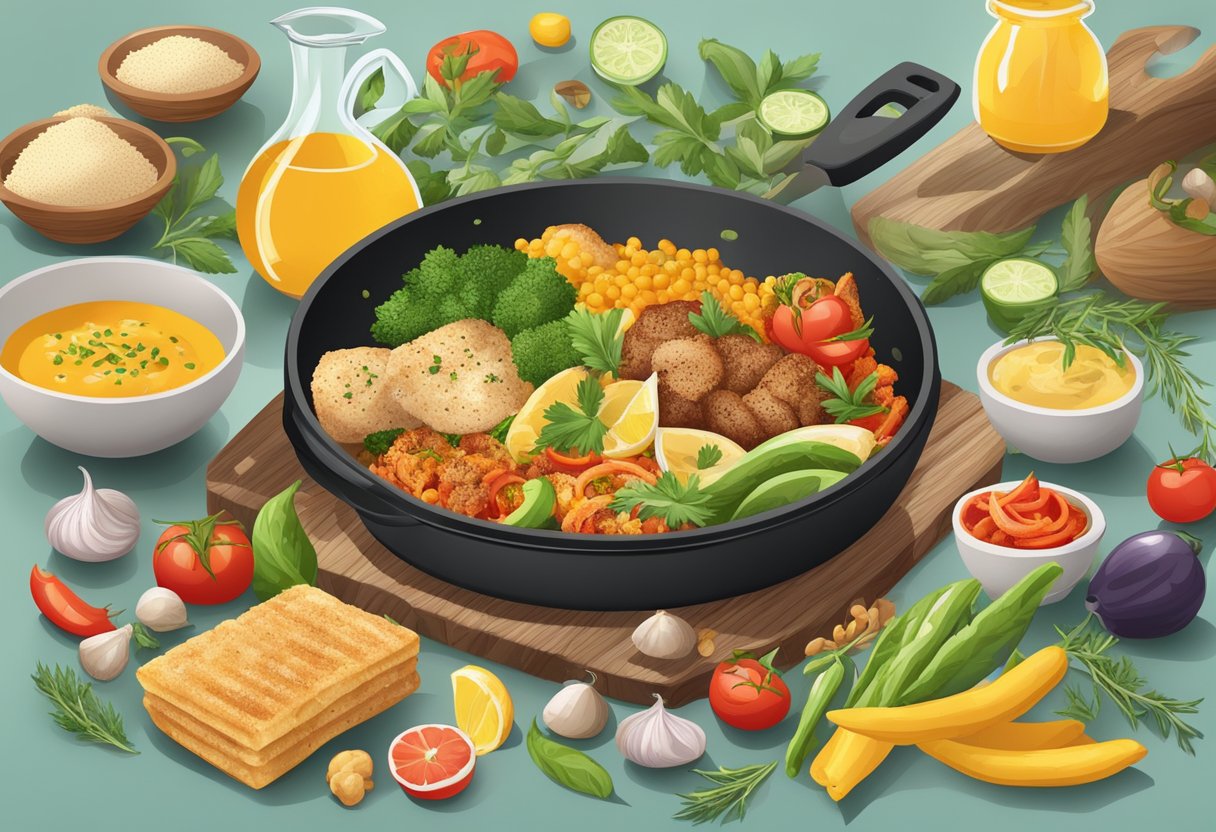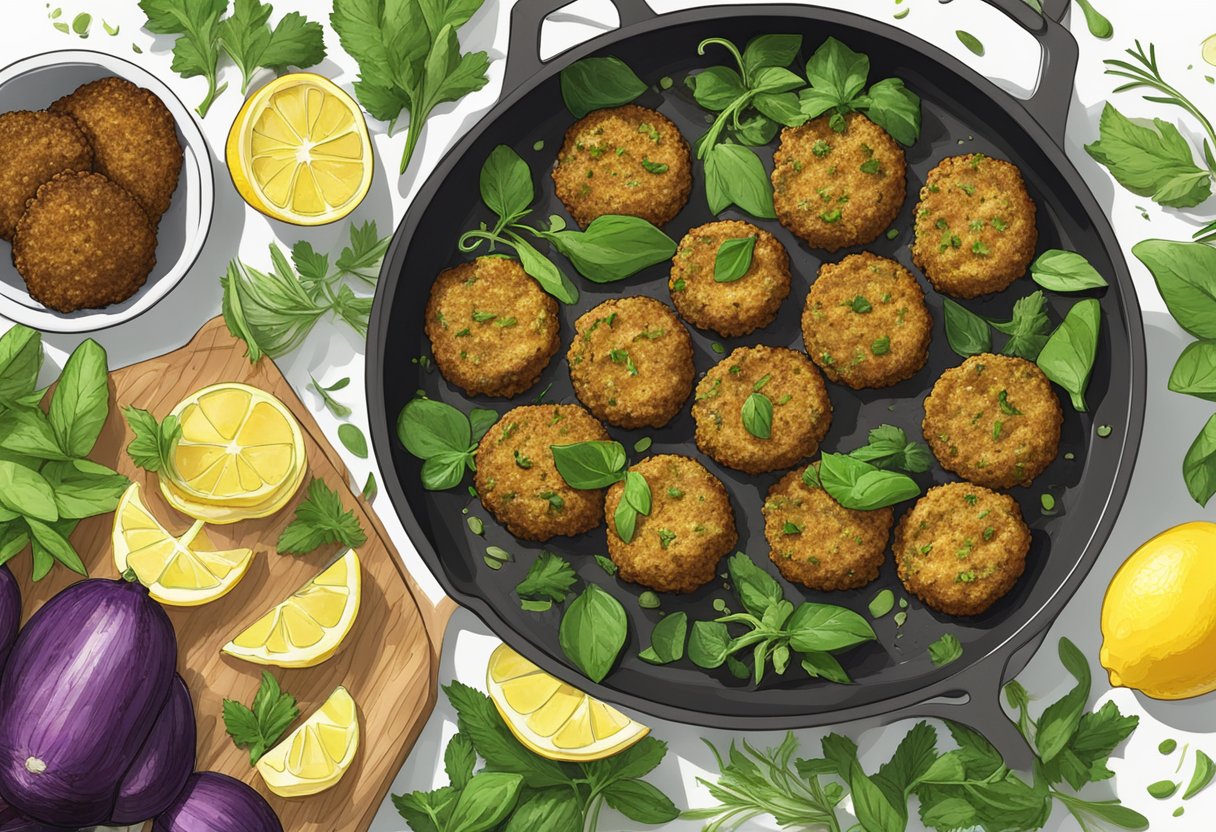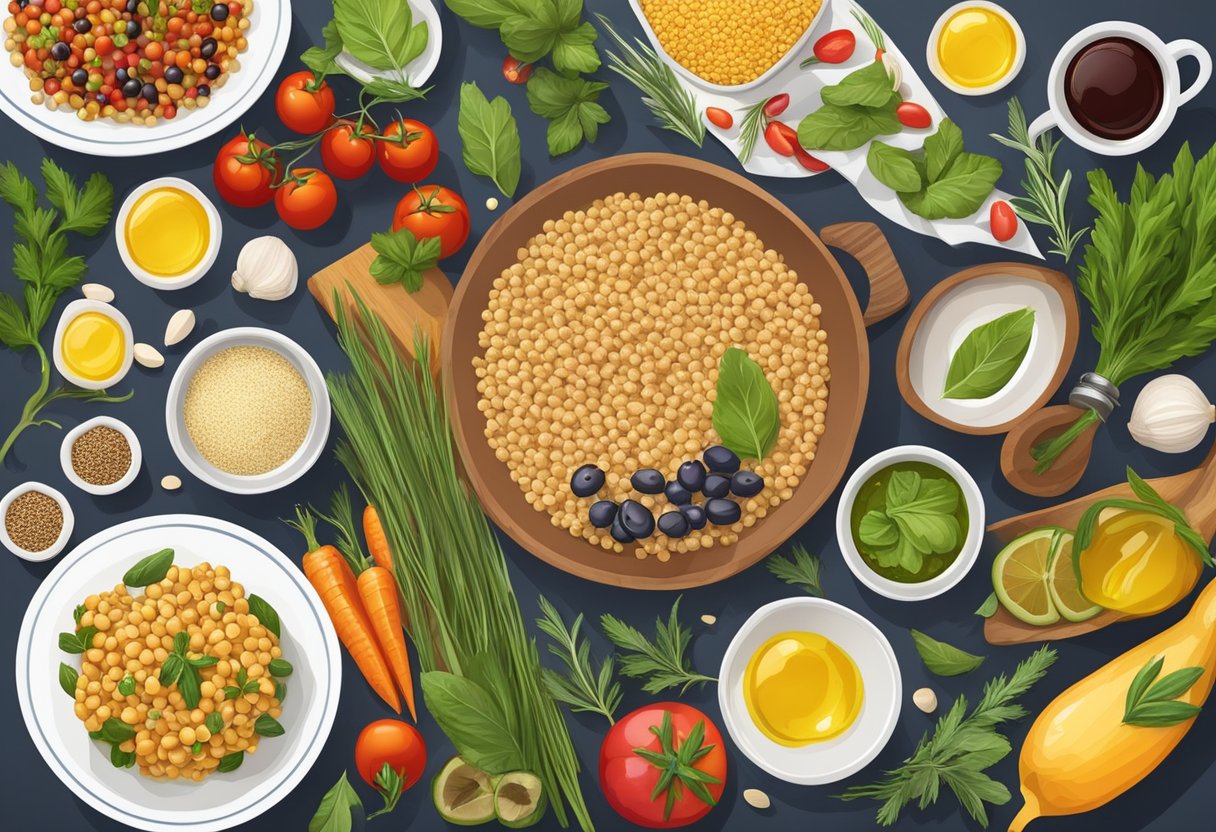Adopting a gluten-free version of the Mediterranean diet can be both a health-conscious and flavorsome choice, especially for those dealing with celiac disease or gluten sensitivities. While the Mediterranean diet is lauded for its balance of vegetables, fruits, legumes, and lean proteins, many might assume that fried foods are off the table. However, with careful ingredient selection and preparation methods, it is entirely possible to incorporate fried dishes without compromising the gluten-free integrity or the heart-healthy principles of the diet.

In the realm of gluten-free eating, the judicious use of alternative flours such as almond or chickpea flour allows for the continuation of traditional frying methods. These substitute flours not only align with the Mediterranean diet’s emphasis on whole foods but also provide a safe way to enjoy fried foods. Furthermore, the diet’s rich use of olive oil offers an ideal medium for frying, contributing both to the flavor profile and to the nutritional value of the dishes, given olive oil’s beneficial fat content.
Key Takeaways
- Gluten-free flours offer safe alternatives for fried foods in the Mediterranean diet.
- Olive oil is a staple for frying, enhancing both taste and health benefits.
- A gluten-free Mediterranean meal plan can be both diverse and satisfying.
Table of Contents
Understanding the Gluten-Free Mediterranean Diet

The Gluten-Free Mediterranean Diet combines the heart-healthy aspects of the Mediterranean lifestyle with the necessary avoidance of gluten for those with sensitivities or celiac disease.
Principles of the Mediterranean Diet
The Mediterranean Diet is lauded for its balanced approach to eating, emphasizing whole grains, fruits, vegetables, legumes, healthy fats like olive oil, and a moderate intake of fish and poultry. Red meat and sweets are consumed sparingly to maintain a diet that supports cardiovascular health.
Adapting to Gluten-Free Needs
To accommodate a Gluten-Free Diet, traditional grains such as wheat, barley, and rye are replaced with gluten-free alternatives like quinoa, rice, and certified gluten-free oats. This adaptation is crucial for individuals with Celiac Disease, who must avoid gluten to prevent health complications.
Health Benefits of a Gluten-Free Lifestyle
Apart from addressing the needs of individuals with gluten sensitivity, a gluten-free lifestyle can reduce inflammation and may lower the risk of Heart Disease and certain types of Cancer. The Celiac Disease Foundation and various Registered Dietitians recommend a gluten-free Mediterranean diet for its potential health benefits.
Integral Components of the Diet

The gluten-free Mediterranean diet emphasizes whole foods rich in nutrients with particular attention to gluten-free options. It prioritizes fresh produce, lean proteins, and healthy fats, ensuring a wide array of vitamins, minerals, and other beneficial compounds.
Fruits and Vegetables
Fresh fruits and vegetables are cornerstones of the diet, providing essential vitamins, minerals, and fiber. It’s recommended to have a variety of colors on the plate to maximize the intake of different nutrients.
- Vegetables: Leafy greens, bell peppers, tomatoes, cucumbers, etc.
- Fruits: Berries, apples, pears, citrus fruits, and others that are naturally gluten-free.
Gluten-Free Whole Grains and Seeds
Replacing traditional gluten-containing grains with gluten-free whole grains and seeds is necessary for those with celiac disease or gluten sensitivity. They are important sources of B vitamins and fiber.
- Grains: Quinoa, rice, millet, and buckwheat.
- Seeds: Sunflower seeds, chia seeds, and flaxseeds.
Protein Sources
Adequate protein intake is ensured by including a variety of legumes, fish, poultry, and eggs into the diet. Legumes also contribute fiber and other essential nutrients.
- Legumes: Lentils, chickpeas, and beans that are all naturally gluten-free.
- Fish and Seafood: Salmon, mackerel, and shrimp, consumed twice a week.
- Poultry and Eggs: Lean chicken, turkey, and eggs are included in moderation.
Fats and Oils
Healthy fats are a key feature, with a focus on monounsaturated fats known for their heart-healthy properties.
- Oils: Extra virgin olive oil is the main source of fat and used generously.
- Nuts: Almonds, walnuts, and pistachios contribute both healthy fats and protein.
Dairy is included in the diet but in moderation, preferably in fermented forms such as Greek yogurt and cheese, which offer probiotics and additional protein.
Gluten-Free Alternatives for Traditional Ingredients

In a gluten-free Mediterranean diet, selecting the right ingredients is crucial. This section provides specific alternatives to traditional ingredients that contain gluten.
Choosing Safe Grains and Flours
Safe grains and flours are the cornerstone of gluten-free cooking. Quinoa and buckwheat are excellent choices, providing not only a gluten-free alternative but also a boost in protein and fiber. Rice, in all its varieties, serves as a versatile base for many dishes. For baking and breading, corn flour or finely ground almonds can provide a satisfying crunch without the gluten. It’s also important to choose oats that are certified gluten-free, as regular oats can be contaminated with gluten during processing.
Legumes and Nuts as Nutrient-Dense Substitutes
Legumes like lentils and chickpeas are a staple of the Mediterranean diet and a gluten-free must-have. They offer a high-protein, high-fiber addition to any meal. Nuts such as almonds and walnuts are not just gluten-free but are also packed with healthy fats and essential nutrients, making them an ideal snack or salad topping for those on a gluten-free Mediterranean diet.
Dairy and Cheese Options
Dairy products can complement a gluten-free Mediterranean diet well, as they generally do not contain gluten. Greek yogurt is a versatile ingredient that can be used in both savory and sweet dishes, adding creaminess and a probiotic boost. For cheeses, many traditional options like feta and Parmesan are naturally gluten-free and add depth to various recipes. Always verify labels though, to ensure that no gluten-containing additives have been used.
Safe Preparation of Gluten-Free Fried Foods

For individuals following a gluten-free Mediterranean diet, especially those with Celiac disease, it is critical to employ safe food preparation methods to avoid cross-contamination and to use healthy cooking techniques and ingredients that align with the diet’s principles.
Understanding Cross-Contamination
Cross-contamination is a serious concern for individuals with Celiac disease or gluten sensitivity. It occurs when gluten-free foods come into contact with gluten-containing foods or surfaces, which can happen during the frying process if careful measures are not taken. To prevent cross-contamination, dedicated kitchen equipment, such as a non-dedicated fryolator, should be used solely for gluten-free frying. Cooks should also thoroughly wash their hands and change gloves before handling gluten-free food items.
Frying Techniques and Best Practices
When frying gluten-free foods as part of a Mediterranean diet, it is best to use healthy oils such as olive oil, which is a staple of the diet. The oil should be kept at a consistent temperature to ensure foods are cooked properly, without absorbing excess oil. Additionally, it is important to use separate fryers or thoroughly cleaned pans to ensure there is no residue from previous gluten-containing foods. Parchment paper or foil can be used to protect food from surfaces if needed, as advised by The Gluten Free Mentor.
Gluten-Free Breading and Batter Alternatives
Traditional breading and batter often contain gluten, posing a risk for those on a gluten-free diet. Alternative gluten-free ingredients include almond flour, cornmeal, and gluten-free breadcrumbs for breading. For batter, chickpea flour or a gluten-free all-purpose flour blend can be used. These alternatives not only prevent gluten exposure but also provide additional nutrients, aligning with the healthy eating goals of the Mediterranean diet.
Recipe Inspirations

Finding gluten-free options for a Mediterranean diet doesn’t have to be challenging. The varied use of vegetables, lean proteins, and healthy fats ensures that meals are not just nutritious but also deeply flavorful. Here are collections of recipes for every meal that stay true to the principles of the Mediterranean diet, free of gluten.
Cooking Gluten-Free Mediterranean Breakfasts
Breakfast on the Mediterranean diet can be both invigorating and satisfying. Gluten-free Mediterranean breakfast bowls incorporate eggs, which are a fantastic source of protein to start the day. For a touch of color and nutrition, they can layer tomatoes and greens, sautéed with garlic for a flavor boost. Another option is a platter of smoked salmon and avocado, delivering omega-3 fatty acids important for heart health.
Lunches Packed with Nutrients
Lunch options include bountiful salads and nutrient-dense grain bowls. One can create a robust Mediterranean tuna salad with ingredients like fresh greens, cucumbers, and tomatoes, tossed with a simple dressing of extra virgin olive oil and lemon. Substituting traditional grains with quinoa makes a gluten-free base for a Greek quinoa salad brimming with vegetables and topped with grilled chicken or chickpeas.
Delectable Dinners
Dinner time is an opportunity for gathering and savoring bold flavors. Baked garlic and lemon chicken brings zest to the table, paired with gluten-free grains like millet or a side of roasted vegetables. Fish, such as seared salmon atop a bed of pilaf made from cauliflower rice, offers a meal rich in protein and essential nutrients, keeping the gluten-free promise.
Healthy Snacks and Treats
Snacks are a delightful way to incorporate more fruits, vegetables, and nuts into the diet. Handfuls of almonds or walnuts provide energy and are packed with healthy fats. For a quick snack, one might enjoy stuffed date packages with an almond nestled in each, offering a sweet treat without straying from the diet’s guidelines. Homemade tomato and onion bruschetta over gluten-free toast serves as a refreshing and light bite any time of day.
Creating a Gluten-Free Mediterranean Meal Plan

Crafting a meal plan for a Gluten-Free Mediterranean Diet involves mindful structuring of meals and portions, ensuring a diverse range of foods, and preparing a detailed shopping list. These steps make it possible to enjoy a varied diet that excludes gluten while adhering to Mediterranean diet principles.
Structuring Daily Meals and Portions
For those following this diet, emphasis is on plant-based foods like fruits, vegetables, legumes, and nuts, with moderate amounts of poultry and seafood. Each day should start with a balanced breakfast, such as a frittata with spinach and feta. Lunch and dinner can include quinoa salad or grilled fish with mixed vegetables. Portions should reflect personal dietary needs while maintaining nutrient balance.
Incorporating Variety
A Gluten-Free Mediterranean Diet thrives on variety. Vegetarian and vegan options are abundant, such as falafel made from chickpeas and salads with an assortment of fresh vegetables. Adding different herbs and spices contributes to a rich flavor profile without the need for gluten-containing ingredients. Occasional inclusion of red meat in small portions can fit into the dietary pattern, but focus should remain on plant-based meals.
Shopping List and Pantry Staples
When preparing a shopping list, prioritize gluten-free whole grains like brown rice and certified gluten-free oats. Fresh produce should dominate the list, alongside proteins like lentils, beans, and tofu for vegetarians and vegans. Seafood and poultry are ideal for non-vegetarians, and staples such as extra-virgin olive oil, nuts, seeds, and dairy alternatives should be included. Pantry staples must be carefully selected to ensure they are gluten-free, which is crucial for maintaining a strict gluten-free diet.
Lifestyle Considerations

Adopting a gluten-free Mediterranean diet can impact various aspects of a person’s lifestyle, especially when it comes to managing a social life, maintaining physical activity, and focusing on long-term health objectives.
Eating Out and Social Events
When individuals embrace a gluten-free Mediterranean lifestyle, restaurant choices and menu options may be more limited. It’s important for them to communicate dietary restrictions clearly and seek out establishments that cater to gluten-free needs, promoting a safe and enjoyable dining experience. They also benefit from the diet’s emphasis on fresh, whole ingredients, which can often be more easily accommodated in social settings.
Physical Activity and the Mediterranean Lifestyle
The Mediterranean lifestyle goes beyond diet, incorporating regular physical activity as a cornerstone. Engaging in daily exercise such as walking, swimming, or cycling complements the diet’s health benefits, aiding in weight management and improving blood sugar control, which can be particularly beneficial for individuals at risk for or managing Type 2 Diabetes.
Long-Term Health Improvements
Long-term adherence to a gluten-free Mediterranean diet may contribute to reduced chronic inflammation, a common factor in chronic diseases. The nutrient-dense foods in this diet are linked to a lower risk of diseases like Alzheimer’s, and can promote overall health benefits including better heart health and improved blood sugar levels, potentially mitigating the risk of Chronic Disease and supporting a healthier lifestyle for years to come.
Frequently Asked Questions

Navigating a gluten-free Mediterranean diet successfully requires an understanding of how to replace traditional wheat-based ingredients with gluten-free alternatives. Here are some specific FAQs to assist in meal planning and cooking.
What are some staple foods to include in a gluten-free Mediterranean diet meal plan?
A gluten-free Mediterranean diet incorporates plant-based foods like fruits, vegetables, legumes, nuts, seeds, and olive oil. Whole grains such as quinoa and millet replace traditional gluten-containing grains.
Which gluten- and dairy-free recipes are most recommended for a Mediterranean diet?
Recipes that feature fish and seafood, alongside a variety of vegetables seasoned with herbs and spices, are highly recommended. Dishes using legumes and nuts as protein sources are also popular.
How can you adapt traditional Mediterranean dishes to be gluten-free?
To adapt traditional dishes, they can substitute wheat flour with gluten-free alternatives such as almond, coconut, or chickpea flour for making bread or pasta. They should also ensure that sauces and condiments are gluten-free.
Where can I find the best gluten-free Mediterranean diet cookbooks?
The best gluten-free Mediterranean diet cookbooks can be found at bookstores, libraries, and online platforms. Many celiac disease foundations offer recommendations for top-rated cookbooks tailored to gluten-free living.
Are there any gluten-free Mediterranean breakfast options?
Yes, there are several gluten-free Mediterranean breakfast options, including Greek yogurt with honey and nuts, omelets with fresh vegetables, or millet porridge with fruit.
Is there a meal delivery service that caters to a gluten-free Mediterranean diet?
Several meal delivery services cater specifically to a gluten-free Mediterranean diet, providing convenient options that align with dietary restrictions and preferences. It’s essential to check that these services are certified gluten-free to prevent cross-contamination.



